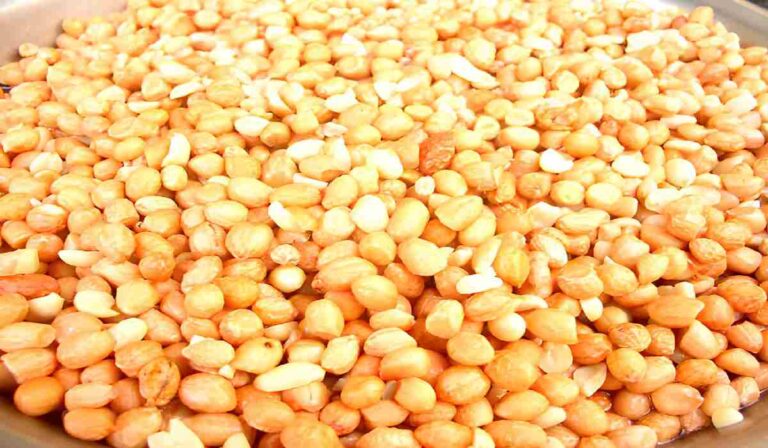Are Peanuts Peas or Nuts
Are peanuts peas or nuts? It’s a question that’s likely crossed your mind while munching on a handful of these tasty snacks or spreading peanut butter on your morning toast. At first glance, the name “peanut” suggests it’s a nut, but the truth is a bit more complicated—and fascinating! Let’s dig into the science, history, and fun facts about peanuts to clear up the confusion once and for all.
Table of Contents
Peanuts: A Botanical Breakdown
Despite their name, peanuts are not nuts—they’re legumes. Botanically speaking, peanuts (scientifically known as Arachis hypogaea) belong to the same family as beans, lentils, and peas. This family, called Fabaceae, is known for plants that produce pods with seeds inside. Unlike true nuts, which grow on trees and have a hard shell (think almonds or walnuts), peanuts grow underground in soft, fibrous pods, much like peas.
So why the nutty confusion? The “nut” in peanut comes from its culinary use and flavor profile. Peanuts have a rich, nutty taste and are used in recipes like homemade peanut butter or roasted snacks, which makes people associate them with tree nuts. But botanically, they’re closer cousins to chickpeas than cashews!
What Makes a Legume Different?
Legumes are plants that produce seeds in pods and have a unique ability to “fix” nitrogen in the soil, making them great for sustainable farming. Peanuts grow underground (hence the alternate name “groundnut”), and each pod typically contains 2–3 seeds, which we call peanuts. This underground growth sets them apart from peas, which grow above ground in green pods, but both are legumes with similar pod structures.
If you’re curious about other legumes, check out our guide on the health benefits of lentils for more on this nutritious plant family!
A Brief History of Peanuts
Peanuts have a rich history that spans thousands of years. Originating in South America, they were cultivated as early as 1500 BCE in Peru. Spanish explorers brought peanuts to Europe, and from there, they spread to Africa and Asia. Today, peanuts are a global staple, especially in the U.S., where they’re a key ingredient in everything from peanut butter to ballpark snacks.
Did you know the U.S. produces about 7% of the world’s peanuts, with Georgia leading as the “Peanut State”? For more fun food facts, explore our post on America’s favorite snacks.
Nutritional Powerhouse: Why Peanuts Are Good for You
Whether they’re peas or nuts, peanuts pack a nutritional punch. They’re loaded with protein, healthy fats, fiber, and essential nutrients like vitamin E, magnesium, and folate. Here’s a quick breakdown of what a 1-ounce serving (about a handful) offers:
- Protein: ~7 grams, great for muscle repair and satiety
- Healthy Fats: Mostly monounsaturated fats, which support heart health
- Fiber: ~2 grams, aiding digestion
- Antioxidants: Compounds like resveratrol may reduce inflammation
Peanuts are also budget-friendly and versatile, making them a go-to for healthy snacking. Worried about peanut allergies? Our article on managing food allergies dives deeper into this topic.
Are Peanuts Good for Everyone?
While peanuts are nutrient-dense, they’re not for everyone. Peanut allergies affect about 1–2% of people and can cause severe reactions. Always check with guests before serving peanut-based dishes, and if you’re curious about safe alternatives, read our guide on nut-free snacks.
Peanuts in the Kitchen: Versatile and Delicious
Peanuts shine in both sweet and savory dishes. From classic peanut butter to spicy peanut sauces in Asian cuisine, their versatility is unmatched. Here are a few ideas to try:
- Peanut Butter: Spread it on toast, blend it into smoothies, or use it in healthy peanut butter cookies.
- Roasted Peanuts: Toss with spices for a crunchy snack.
- Peanut Soup: A creamy, West African-inspired dish that’s hearty and flavorful.
For recipe inspiration, check out our easy peanut butter recipes for more ways to enjoy this legume.
Peanuts vs. Tree Nuts: Culinary Differences
In the kitchen, peanuts and tree nuts like almonds or pecans are often used interchangeably, but there are differences. Peanuts have a softer texture when roasted and a more pronounced earthy flavor. Tree nuts, like walnuts, tend to be crunchier and have distinct flavor profiles. If you’re wondering how to substitute them, our guide to nuts in baking can help.
Fun Facts About Peanuts
- Not Just for Eating: Peanuts are used in products like soap, paint, and even explosives (thanks to their oil content).
- Space Snack: Peanut butter has been taken on NASA missions for a protein-packed boost.
- Boiled Peanuts: A Southern U.S. delicacy, boiled peanuts are soft, salty, and addictive.
Want more quirky food trivia? Our post on surprising food origins is packed with tidbits like these!
Peanuts Around the World
Peanuts play a starring role in global cuisines:
- Asia: Think pad thai with peanut sauce or satay skewers.
- Africa: Peanut stew is a comforting, spicy dish in many West African countries.
- Americas: From PB&J sandwiches to peanut brittle, the U.S. loves its peanuts.
Explore more global flavors in our international recipes collection.
Growing Your Own Peanuts
Believe it or not, peanuts are easy to grow at home if you have a warm climate and sandy soil. They need about 120–150 days of warm weather and well-drained soil. After planting, the plants produce yellow flowers, and the “pegs” (stems) burrow into the ground to form peanut pods. Harvest when the leaves turn yellow, and you’ve got fresh peanuts! For more gardening tips, see our guide to growing legumes.
Clearing Up the Confusion
So, are peanuts peas or nuts? Botanically, they’re legumes, closely related to peas but distinct in their underground growth and culinary uses. In the kitchen, though, their nutty flavor and versatility make them a beloved “nut” in dishes worldwide. Whether you’re snacking on roasted peanuts, spreading peanut butter, or cooking a savory peanut stew, this legume is a nutritional and culinary superstar.


